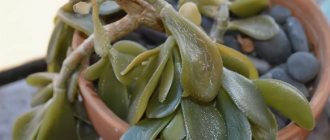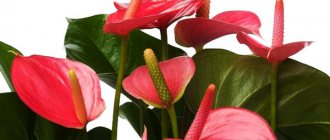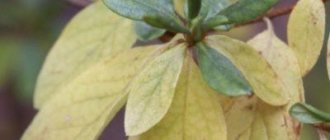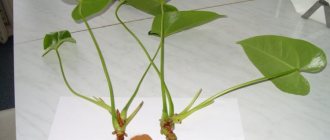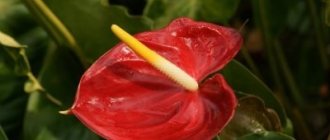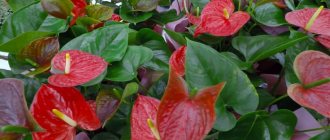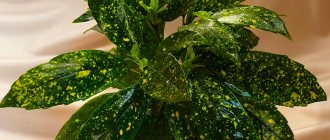Anthurium is an overseas guest on our windowsills. Many amateur flower growers know it as “male happiness” and “flamingo flower.” It pleases with its long flowering regardless of the time of year. Bright waxy flowers, as if made of paraffin, attract attention. In our country, the most common anthurium is the one with the red flower. But, besides it, there is also purple, and white, and pink.
An inexperienced gardener may think that anthurium does not require care. But, by its nature of origin, it is accustomed to a warm climate, fairly bright but not scorching color, light soils and fairly humid air. Anthurium quickly adapts to the conditions of its new home, gives good growth and blooms. But, out of the blue, it suddenly starts to hurt. Most likely, this is due to stress from new conditions. Therefore, the first way to prevent diseases is to strictly adhere to agricultural techniques for growing anthurium.
Most often, the leaves of the flower suffer from various diseases. We will consider further what diseases of anthurium can manifest themselves, what they look like in the photo and how to treat them.
Anthurium diseases can be divided into three root causes:
- Failure to comply with agricultural cultivation techniques.
- Infectious diseases.
- Insect pest damage.
Violation of growing conditions.
When growing anthuriums, it is necessary to take into account the lighting in the room ; if there is a lot of it and there is direct sunlight, they should be shaded. Or move them to a more different place. Be sure to take into account the temperature regime for growing anthurium.
Most anthuriums prefer warmer growing conditions; some can tolerate lower temperatures. It is necessary to pay attention to planting anthuriums and their transplantation. During such events, the plant experiences stress. Since its growing conditions are violated and your anthurium has to get used to the new conditions for some time after planting/transplanting .
Watering anthurium and feeding is perhaps the main point in growing. All types of anthurium are not allowed to overdry the earthen ball; they also react painfully to excess moisture. If the norms and characteristics of watering are violated, problems with the appearance of diseases may arise . Pests can also cause harm .
Regardless of the reasons that arose when growing anthurium, any change or violation of conditions is primarily reflected in the appearance of leaves and flowering. The leaves may turn yellow, become spotted, simply begin to fall off, and may be affected by pests and diseases. The decorative component may also be lost if it becomes cramped in its pot and it has outgrown it too much.
The falling of leaves on an anthurium does not mean that it is dying or sick. It is necessary to take into account the natural death of leaves during development and growth.
Darkening of green mass
If the leaves begin to darken, while the roots also suffer, and the stem section is limp, this may indicate the presence of an increased concentration of a microelement such as calcium in the soil substrate. An excellent solution to the problem is to transplant the flower into a higher quality soil mixture with a balanced composition, selected specifically for epiphytes (for example, soil substrate for orchids).
Fertilizer application must also be done correctly. It is not recommended to feed the soil too often; this can damage both roots and leaves.
Lighting and sun
Light plays an important role in growing anthuriums at home. This point is especially important for anthuriums with variegated and colorful inflorescences. With insufficient lighting, anthurium leaves become duller. In bright and strong lighting - especially if we are talking about the sunny side of your house. Direct sunlight can cause sunburn on leaves. At the same time, brown spots appear on the leaves, which can destroy the basic structure of the leaf and cause it to wither and further fall. In case of insufficient lighting, the leaves become smaller and stretch towards the light, and flowering also stops or is reduced.
Solution to the problem: in case of insufficient lighting, you can use additional lamps or use phytolamps. But in bright sunlight, we shade the anthuriums and move them to a place where there is no direct sunlight.
Viral diseases
Among the viruses that affect anthurium is the bronze virus.
Bronzing virus
An unpleasant disease that manifests itself as discoloration of plant foliage. With the armed eye, you can notice pronounced wrinkles and small through dots on the surface of the sheet.
The virus is spread by insects, such as thrips. The disease cannot be treated; it cannot be cured. The diseased specimen will have to be thrown away. And other indoor plants need to be inspected for the presence of thrips so that they cannot spread the bronzing virus. For processing, you can use Actellik or Aktar.
Temperature
Temperature is very important, especially considering the tropical origin of anthuriums. Maintaining a stable and constant temperature is the key to good development. If the air is dry, the tips of the leaves may dry out. With sudden changes in temperature, which can be caused by drafts or differences between the heating and the window frame, problems with leaves and inflorescences also arise.
Solution to the problem: avoid sudden temperature fluctuations. Avoid drafts (especially when ventilating the room). Try to choose the very place in which your anthurium will feel ideal. If the air is dry, we use air humidifiers or wet spraying; you can also wipe the leaves with a damp cloth. When spraying flowering anthuriums, try not to get moisture on the inflorescences, otherwise they will begin to become stained.
Anthurium leaves turn yellow - it is necessary to find out the reasons and reconsider the growing conditions.
Buy a rooted baby or flowering anthurium
You can buy one blooming Anthurium, depending on the variety and age of the flower, in the range from 600 to 700 rubles. A rooted shoot (baby) of anthurium can be purchased from 350 rubles. If the cost of ordered indoor flowers (plants) is 3,000 rubles or more, then we add one plant for free. The minimum amount for any purchase is 1000 rubles.
We do not send plants by cash on delivery!
For the availability of anthuriums in our nursery, see the “Anthurium Catalog” section.
When choosing anthuriums, instead of the name, you can indicate the number of the flower in the photo.
Catalog of anthuriums: photos and descriptions.
Planting and transplanting
When purchasing an anthurium, it must be transplanted to a permanent place. If your anthurium is old enough and its roots no longer fit into its pot, it should be replanted. Young. First, we take it out of the pot, and then plant it in a new one. Any disturbance in the root system is always reflected in its leaves - they begin to either dry out and fall off, or curl, dry out and fall off. Especially considering the fragility of the roots of anthuriums.
Solution to the problem: when planting or replanting, we try to minimize disturbance to the roots. If you have purchased a plant, carefully remove it from the pot and without breaking the earthen lump, place it in the same condition in a new pot. Try not to disturb the integrity of the root system that has already formed and is intertwined with the soil. Damp soil holds roots together better than dry soil. When planting or transplanting, the roots can be treated with a root formation stimulator (kornevin). When watering, you can use products such as epin, zircon.
Fusarium wilt
Fusarium wilt is an infectious disease that can affect not only anthurium, but also many other indoor plants. It affects the root system, trunk and leaves of the flower. Characterized by unexpected and rapid withering of the entire plant. You can see a pale pink coating on the root collar. The disease develops rapidly in warm and humid conditions. So watering the flower will only accelerate the development of the disease.
Anthurium disease Fusarium wilt can be recognized at an early stage. If the gardener notices bending of flower stalks and yellowing of leaves. It is possible to overcome an infection only at the very beginning of its development. The anthurium bush needs to be removed from the pot, the roots should be thoroughly washed under running water, then soaked in a solution of foundationazole. Afterwards, trim off all affected and unhealthy areas on it. Then transplant the flower into fresh soil and a new pot. The bush is treated with copper-containing preparations.
Watering and fertilizing
This issue should be approached very carefully. All anthuriums, regardless of type, do not tolerate excess moisture and drying out of the earthen coma. Stagnation and too wet soil leads to rotting of the root system and greatly affects the leaves. They begin to turn black and gradually dry out and crumble. It’s the same story with the drying out of the earthen coma. The leaves begin to fade and gradually fade. An excess of moisture or a lack of it affects the roots of the plant, hence the problems with the leaves. Because the watering conditions are violated. As for feeding, its lack can affect the development of shoots and leaves, as well as reduce flowering. They may become smaller and develop poorly. Also, a lack of certain nutrients may be reflected in the leaf itself. Too much fertilizer can also be harmful. Lack or excess of fertilizing affects the timing and quality of flowering.
Solution to the problem: control watering and fertilizing. When planting, the pot must have good drainage. If there are not enough drainage holes in the pot, make additional ones. If your planter or pot has an automatic watering function or combines both a planter and a container for planting at the same time. Watering is controlled. The soil should have time to dry a couple of centimeters before each subsequent watering. You can determine the need for watering using special devices to determine humidity. There are devices that will indicate to you the need for watering and soil fertility. Or you can check the soil moisture with a match - it should be stuck into the soil and, if there is soil left on the match, you should wait a while with watering.
But I advise you to carry out fertilizing within the specified time frame (active growth and vegetation of the indoor plant). We also take into account the resting phase. Always study the instructions and fertilizer rates. It is better to reduce the dose a little rather than give more. Excess fertilizer or a strong solution can burn the root system and cause harm. Use liquid mineral and organic fertilizers for indoor plants, which can be diluted in water for irrigation.
Why leaves of male happiness turn yellow and dry: causes and treatment at home
The home flower reacts very sensitively to conditions of maintenance and care.
Various reasons lead to yellowing, wilting and falling of leaf blades:
- incorrect transplantation;
- unsatisfactory temperature conditions;
- excessive or poor watering;
- deficiency or excess of lighting;
- depleted or compact soil;
- overdose of fertilizers;
- damage by harmful insects;
- rotting of the root system;
- fungal diseases.
In addition, dry air in a rarely ventilated room or cold drafts can cause loss of decorativeness. Anthurium disease can be diagnosed by special signs of yellowing and wilting of leaf blades.
Along the edges
Dry spots of yellow-brown color that form along the edges of the leaf blades indicate improper watering. The tropical culture prefers moderately moist soil, but absolutely cannot tolerate stagnant water.
<
Before each watering procedure, it is necessary to check the condition of the soil : its top layer should dry out 1.5-2 cm deep. After moistening the substrate, the remaining water flowing into the tray must be drained immediately.
Attention! Yellowing lower leaves are a normal phenomenon inherent in adult plants older than 2-3 years. Old leaves die off without negatively affecting the overall development of the flower.
Leaf tips
Dry leaf tips that form on the anthurium crown indicate insufficient moisture of the substrate. The plant needs systematic watering. In this case, the water must be soft (settled, purified, rain or melt).
Another reason for darkening of the tips of leaf blades is too dry air in the room. Tropical crops require high humidity, which is provided by frequent spraying of the crown. This is especially necessary in hot weather.
To humidify the air, you can use special devices or place bowls of water next to the flowerpot. A good effect is achieved by placing wet moss in the tray of a flower pot or placing the plant near the aquarium.
Important! The water temperature for watering and spraying the crown should be 2-3 degrees higher than in the air.
Spots
Yellow, brownish and blackening spots of various shapes and sizes, if they are dry and do not grow in size, should not cause concern. Such phenomena occur even due to the movement of a plant from one room to another. When changing places, the lighting may become insufficient, or, conversely, too bright. Sometimes spots on the crown of an anthurium are traces of sunburn.
In addition, dry marks on the leaves may indicate a lack of microelements in the soil necessary for good vegetation. This situation can be corrected by revising the feeding diet. As fertilizers, it is best to use ready-made liquid complexes sold in flower shops.
Yellow and dark spots that are constantly growing in size pose a serious danger to tropical crops. They indicate that the plant is infected with fungal infections. In this case, anthurium is isolated from other indoor crops and treated with fungicides.
Important! When feeding anthurium with liquid complexes, you should reduce the dosage of fertilizer specified in the instructions by at least 2 times.
Pests and diseases
Both are the cause of violation of growing conditions. Diseases, and in particular fungal diseases, can appear in the pot if watering is not correct. Pests can appear when the plant weakens, when they are introduced with the soil or from another plant. Sometimes pests or diseases may already be present on the plant when it is sold.
Solution to the problem: diseases are mainly associated with the root system. Root rot can form when moisture stagnates, then it spreads to the shoots and trunk. If you do not notice the problem in time, you can lose the plant. As a preventive measure, in the early stages of the problem, let the earthen coma dry well. Next, we use the appropriate medications. It’s the same with pests – when we detect them, we take all necessary measures for control and prevention. In case of partial infection, we use appropriate preparations; in case of severe infection, we move the plant to a separate place and quarantine it. Using the necessary pest control product.
Why anthurium leaves turn yellow can only be understood by studying the reason.
Prevention measures
Proper care of green pets allows you to avoid a lot of problems. Timely and rational watering, sufficient fertilization, optimal lighting and air temperature will allow the flower to feel good and delight the owner with its beautiful blooms.
Unlike fungal diseases, which often appear due to improper care, parasitic diseases damage even well-cared for plants. To avoid many problems, you need to carefully monitor the anthurium and inspect the leaves for pests.
For preventive purposes, it is recommended to give the plant a shower from time to time and wash it with a solution of laundry soap. And if pests are nevertheless noticed, it is necessary to immediately begin to combat them.
Types of diseases and pests of anthuriums
Aphids - the foliage begins to turn yellow and curl. When affected by aphids, young leaves may also turn yellow. The main feature of this pest is its ability to fly from plant to plant. Aphids are especially active during dry periods. In indoor conditions it is unlikely to appear, but when the room is ventilated, it can enter the house from the street. We carry out regular spraying, you can use a soap solution (for mild damage), or special preparations.
pest control products
Nematodes - mainly live in the roots of the plant. They feed on ficus sap and, if damaged enough, the leaves begin to wither and then fall off. It is quite difficult to identify such pests; you need to inspect the top layer of soil. If a plant develops new shoots from the roots, they may not look entirely healthy (weakened or twisted, the leaves on such shoots are poorly formed and do not open completely). To prevent and control this pest, we use an insecticide. If necessary, the plant can be transplanted into new soil by treating both the roots and the soil with appropriate preparations.
Scale insects are small, cinnamon-colored insects. They got their name due to their shape - they look like they are in a shell. Just like with other pests that use plant sap for nutrition, we use appropriate preparations.
Mealybugs are very difficult to remove, so we constantly inspect the plant; this pest can be detected by noticeable discharge on the plants, they are very reminiscent of cotton wool. First, collect them with a cotton swab. And we treat the plant with a soap solution and appropriate preparations. We carry out the treatment constantly, since these insects hide in the axils of the leaves, and it is very difficult to get them out.
pests
Spider mites often attack most indoor plants. This is facilitated by dry air and warm temperatures. The pest is identified by the presence of spots on the foliage. They are white or yellowish. The danger of such a pest is that it is difficult to detect and, if you miss this moment, the damage to your indoor plant will be very severe. We use various insecticides, it is advisable to alternate treatments, since any drug is addictive. You can solve the problem of dry air by constantly spraying the plant or using a humidifier.
Thrips - when infected by this pest, the leaves fall off. Favorable conditions for development are warm temperatures and dry air. A very nimble pest, if not noticed in time and missed, can infect nearby plants. This pest can only be controlled with special preparations (insecticides).
Root rot is caused by fungus growing in the soil. Fungi may already be present in the soil used for planting. And since fungal diseases begin to develop well in high humidity, damp soil, and warm temperatures, the development of this disease begins in the roots. The plant's reaction will be reflected in the leaves, which begin to turn yellow and then fall off. The result is the same - monitor the watering regime. If you have flooded the plant too much, try to let the earthen coma dry out; if it is severely infected, it will not be possible to save it. We throw away both the plant and the pot.
root rot on roots
Leaf spotting can be expressed as either dots or spots. Infected leaves are removed, and the entire plant is sprayed with special preparations or a soap solution.
To summarize, I would like to say that any disease can be prevented, to prevent any diseases and the appearance of pests. Inspect your anthurium frequently for diseases and pests. Anthurium diseases can be prevented rather than treating anthurium diseases for a long time. If they are detected, we immediately begin treatment and preventive methods of control. Use various drugs to fight. Good luck to you.
Rust
A disease of anthurium leaves, such as rust, appears as a result of damage to the plant by rust fungi. They remain viable on the affected leaf. Rust affects not only the leaf itself, but also the stem of the anthurium. Brownish-rusty thickening spots appear on them, like pads. Small spots soon merge, affecting the entire leaf, which soon dries out. A diseased anthurium may bend to one side due to damage to the stem. An infected flower not only loses its decorative effect, but may even die. Because the fungus reduces his vitality. Causes of anthurium leaf disease :
- transfer of fungus from other plants;
- keeping anthurium in too dry conditions;
- too frequent and abundant spraying;
- keeping in an unventilated area.
Leaves with large areas of rust should be removed and burned. The remaining leaves are treated with fungicidal preparations. Bordeaux mixture is suitable both for the treatment of rust and for the prevention of diseases of anthurium leaves. During the treatment period, it is advisable to separate the anthurium from other indoor flowers to avoid infection.

